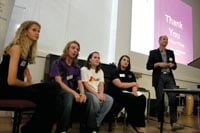A graduate incline?
What can the Creative and Media Diploma offer schools, students and the arts sector at large? Catherine Rose explains

The education world has recently been thrown into uncertainty about the future of qualifications – the market is supposed to take over from the government in deciding which ones will survive. However, options are still open for arts organisations, and particularly their potential to work with the Creative and Media Diploma (CMD). The CMD has proved to be the most successful among a range of ten new 14–19 qualifications being offered in some (though not yet all) schools and colleges in England. Around a quarter of all students taking a Diploma are enrolled on a CMD course at some level. Aspects of the CMD have also been incorporated into the Welsh Baccalaureate. As a result, there is a new demand for work-related learning opportunities, large and small, in the creative sector. Arts organisations with active education departments may already be developing work which meets these needs, but the approach has to be tailored to the new curriculum. Arts Inform has been carrying out pilot research for the Creative and Cultural National Skills Academy (NSA), examining how arts organisations can engage with the CMD. Working with 24 arts organisations in Norwich and Cambridge, we have explored the implications and looked at how students can best gain industry experience.
MAKING IT WORK-RELATED LEARNING
We created an Employer Focus Group in each city, which met four times. As well as disseminating information about the CMD and inviting guest speakers to broaden our knowledge, we used these meetings to create new resources to assist arts organisations and schools to work together with ease and clarity. This process culminated in a seminar on work-related learning (WRL) and the CMD. WRL is a concept which arts organisations can sometimes struggle with. It is distinct from work experience in that it replicates the type of project which someone employed by an arts organisation might carry out. It usually involves setting a brief – such as a project at the Junction in Cambridge which commissioned CMD Level 2 students to create a video promoting its youth band nights, in collaboration with students from Bournemouth University. However, activities could also include attending live events, backstage tours, interviews with key staff and creative projects of the kind which many organisations and individual artists already offer. There is also a thirst for technical and backstage projects, and for working with marketing and the skills associated with mounting cultural events.
Young people presenting at our seminar pointed to the benefits they had experienced working with artists and arts companies – not least the very professional and not always complimentary feedback which they received. They were absolutely clear that there was no substitute for having to answer to an outside organisation, a professional mentor/taskmaster who expects a finished product (whether a video, a report or an event) by a specific date and to a certain standard. One student was on the verge of dropping out of school before this experience: he’s now aiming for, and likely to get, a Creative Apprenticeship with the organisation he worked with.
FINDING TIME AND MONEY
Issues include the question of scale. Cities may have limited capacity to respond to demand. Another is – inevitably – money. Unlike the wider industrial world, the arts sector has no Corporate Social Responsibility (CSR) as such. Under CSR, an architectural practice or manufacturing company might second a member of staff to a project free of charge, whereas in the arts world, most activities must be paid for somehow. Schools do have budgets for this, although individual teachers might not always be aware of them. Arts organisations should encourage schools and colleges to ask whether sufficient status and funding is being committed to this kind of activity, given its value.
A further issue is networking among arts organisations to enable joint approaches to schools – something we are still working on in Cambridge and Norwich. Information for and access to teachers is seen as crucial, not least in order to keep abreast of schools’ needs. Stability, sustainability and the opportunity to showcase work to schools is still a challenge.
The idea that offering WRL implies an offer of potential employment emerged as a cause of some unease to some arts organisations. There is already a glut of young people wanting to become artists or performers. However, the CMD should address the skills shortages – such as backstage and technical staff – which Creative & Cultural Skills has previously identified in its ‘Creative and Cultural Industries Workforce Survey’ (2009) (AP207, AP223). It also develops highly transferrable skills which may also translate into careers in hospitality, tourism, IT or event management. All in all, the reasons for the arts sector to engage with the CMD are powerful and should outweigh these concerns.
What is the Creative and Media Diploma?
• Level 1: The Foundation Diploma Five units including Visual Arts, Performing Arts, Media Production and Presentation Equivalent to 5 GCSEs at grades D to G
• Level 2: The Higher Diploma Seven units including Scene, Performance, Artefact, Campaign and Festival
Equivalent to 7 GCSEs at grades A* to C
• Level 3: The Advanced Diploma Six units including Capture, Show, Commission and Evaluation. Equivalent to 3.5 A levels
Providers: Edexcel (www.edexcel.com), AQA City and Guilds (www.diplomainfo.org.uk) and OCR (www.ocr.org.uk)
Join the Discussion
You must be logged in to post a comment.